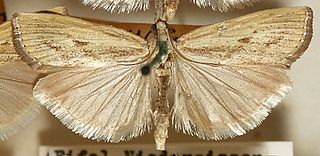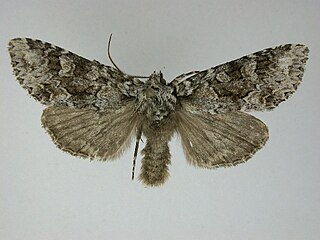
Agriphila geniculea, the elbow-striped grass-veneer, is a species of moth of the family Crambidae. It was first described by Adrian Hardy Haworth in 1811.

Agriphila inquinatella is a small moth species of the family Crambidae. It is found in Europe, around the Caucasus area to Turkestan, and in the Near East to Jordan.

Agriphila is a genus of small moths of the family Crambidae. It was first described by Jacob Hübner in 1825. They are common across temperate Eurasia and in adjacent regions.

Zanclognatha is a genus of litter moths of the family Erebidae. The genus was described by Julius Lederer in 1857.

Agriphila deliella is a species of moth of the family Crambidae. It is found in most of Europe and North Africa and from Anatolia to Afghanistan.

Agriphila argentistrigellus is a species of moth in the family Crambidae. It is found in France, Spain and on Sicily, as well as in North Africa, including Morocco, Libya and Algeria.
Agriphila biarmicus is a species of moth in the Crambidae family. It is found in Fennoscandia, north-western Russia, Estonia, Latvia and in the Alps of Switzerland, Austria and Italy., It is also found in Canada, including Alberta and Quebec.
Leucanopsis longa, the long-streaked tussock moth or long-streaked halisidota, is a moth of the family Erebidae. It was described by Augustus Radcliffe Grote in 1880. It is found from North Carolina to Florida and west along the coast to eastern Texas. The habitat consists of marshes and wet sedge meadows.
Agriphila attenuata is a moth in the family Crambidae. It was described by Augustus Radcliffe Grote in 1880. It is found in North America, where it has been recorded from coastal California, Washington, Wyoming, British Columbia and Alberta. The habitat consists of grasslands.
Agriphila costalipartella is a moth in the Crambidae family. It was described by Harrison Gray Dyar Jr. in 1921. It is found in North America, where it has been recorded from Arizona, California, Nevada and Montana.

Agriphila ruricolella, the lesser vagabond sod webworm, is a moth in the Crambidae family. It was described by Philipp Christoph Zeller in 1863. It is found in North America, where it has been recorded from Quebec and Maine to South Carolina, west to Arizona and north to Alberta. The habitat consists of grasslands, weedy areas, fields and cultivated areas.
Agriphila undata is a moth in the family Crambidae. It was described by Augustus Radcliffe Grote in 1881. It is found in North America, where it has been recorded from California.

Catoptria oregonicus, the western catoptria or Oregon catoptria moth, is a moth in the Crambidae family. It was described by Augustus Radcliffe Grote in 1880. It is found in North America, where it has been recorded from British Columbia and Alberta to Montana, Oregon and northern coastal California. The habitat consists of meadows in the mountains and foothills.
Crambus occidentalis is a moth in the family Crambidae. It was described by Augustus Radcliffe Grote in 1880. It is found in North America, where it has been recorded from Alberta and California.
Pediasia laciniella is a moth in the family Crambidae. It was described by Augustus Radcliffe Grote in 1880. It is found in North America, where it has been recorded from Alberta, California, Illinois, Maine, Michigan, Quebec and Virginia.
Thaumatopsis edonis is a moth in the family Crambidae. It was described by Augustus Radcliffe Grote in 1880. It is found in North America, where it has been recorded from Florida, Kentucky, Maine, Massachusetts, Mississippi, Missouri, Nebraska, New Jersey, Oklahoma and South Carolina. It is listed as threatened in the US state of Connecticut.
Thaumatopsis repandus is a moth in the family Crambidae. It was described by Augustus Radcliffe Grote in 1880. It is found in North America, where it has been recorded from Arizona, British Columbia, California, Colorado, New Mexico, Oregon and Washington.
Evergestis simulatilis is a moth in the family Crambidae. It was described by Augustus Radcliffe Grote in 1880. It is found in North America, where it has been recorded from Alberta, Arizona, British Columbia, California, Colorado, Montana, Nevada and New Mexico.
Egira dolosa is a moth in the family Noctuidae described by Augustus Radcliffe Grote in 1880. It is found in North America.

Platypolia anceps is a species of cutworm or dart moth in the family Noctuidae. It is found in North America.










